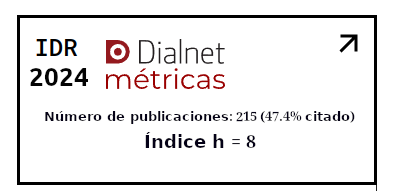Cognitive-behavioral intervention for a high degree of discomfort before work activities: a case study
Keywords:
Case study N = 1, cognitive behavioral treatment, radical acceptance, anxiety, tolerance to discomfort and relaxation trainingAbstract
A case study N = 1 of a 38-year-old adult with a high degree of discomfort when faced with certain work activities is presented. Based on the results, a tailor-made intervention plan is designed with scientific evidence aimed at tolerating and reducing the discomfort that anxiety symptoms present. To prepare this proposal, an evaluation and diagnosis is carried out using the Irrational Ideas Questionnaire (Ellis, 1980), the Attitudes and Beliefs Scale (Lega, Caballo and Ellis, 1997), the Automatic Thought Inventory (Ruiz and Luján , 1991), self-registration of thoughts, the Perceived Stress Scale (PSS) (Cohen, Kamarck and Mermelstein, 1983), the General Self-Efficacy Scale (Baessler and Schwarcer, 1996), the STAI State-Trait Self-Assessment Questionnaire (Spielberger , 1973) and the Derogatis Symptom Inventory-Revised. The SCL-90-R (Derogatis, Lipman y Covi, 1973). A treatment is proposed that includes training in the skills of tolerance to discomfort, radical acceptance, anxiety and relaxation training.
Downloads
References
Airaldi, M. C. (2019). Cartas de psicoeducación emocional. Modelo TREC. SENSORIUM.
Álvarez, O. G. O. (2021). Creencias irracionales en estudiantes del nivel secundario de un centro de educación básica alternativa. Avances en Psicología 29 (2), 221-232.
Asociación Americana de Psiquiatría (2014). Manual diagnóstico y estadístico de los trastornos mentales: DSM-5. (5 ed.). Editorial Médica Panamericana.
Bäbler, J., & Schwarzer, R. (1996). Evaluación de la autoeficacia: Adaptación Española de la Escala de Autoeficacia General [Measuring generalized self-beliefs: Spanish Adaptation of the General Self-Efficacy Scale]. Ansiedad y Estrés, 2(1), 1-8.
Barlow, D. H. (2002). Anxiety and its disorders: The nature and treatment of anxiety and panic. 2 ed. New York: Guilford Press.
Beck, J. (1995). Terapia cognitiva: Conceptos básicos y profundización. Editorial Gedisa.
Brown T. A., O´Leary T. A., & Barlow D. H. (2001). Clinical Handbook of Psychological Disorders: A Step-by-Step Treatment Manual. Nueva York: Guildford Press.
Buela-Casal, G (2008, marzo 07-08). Formulación clínica de casos en trastornos del comportamiento [Conference sessions]. IV Congreso Internacional Multidisciplinar sobre Trastornos del Comportamiento en Menores, Es Baluard Museu d'Art Modern i Contemporani de Palma. Plaça Porta de Santa Catalina, 10. Palma de Mallorca., Palma de Mallorca, Mallorca, España.
Cid, P., Orellana, A., & Barriga, O. (2010). Validación de la escala de autoeficacia general en Chile. Rev Med Chile 138, 551-557.
Clark, D. A., & Beck, A. T. (2012). Terapia Cognitiva para Trastornos de ansiedad. Ciencia y práctica. Biliotéca de Psicología. Desclée de Brouwer.
Cohen, S., Kamarch, T., & Mermelstein, R. (1983). A global measure of perceived stress. Journal of Health and Social Behavior, 24, 385-396. doi:10.2307/2136404
Derogatis, L. R, Lipman, R. S., & Covi, L. (1973). SCL-90: An outpatient psychiatric rating scale. Psychopharmacology Bulletin, 9,13- 27.
Ellis, A. (1980). Discomfort anxiety: A new cognitive-behavioral construct. Rational Living, 15(1), 25-30.
Fundación FORO (2018). Entrenamiento en habilidades (folleto de clase). Olazabal 2015, Buenos Aires, Argentina.
Lang, P. J., Bradley, M. M., & Cuthbert, B. N. (1998). Emotion, motivation, and anxiety: Brain mechanisms and psychophysiology. Biological psychiatry, 44(12), 1248-1263.
Lega, L. I, Caballo, V. E., & Ellis, A. (1997). Teoría y práctica de la terapia racional emotivo y conductual. Madrid: Siglo XXI.
Linehan, M. M. (1993). Manual de formación de habilidades para el tratamiento de los trastornos de personalidad límite. The Guilford Press.
McKay, E., & Navas, R. (2008). Inventario de creencias irracionales. Psichomethric.
Moreno Bermúdez, J. B., Pérez García, A. M., Rueda Laffond, B., Ruíz Caballero, J. A., & Sanjuán Suárez, P. (2012). Psicología de la personalidad. Editorial UNED.
Nava, M., Castillo, C. A., Littlewood, H. F., Heman, H., & Legal, L. (2013). Estructura factorial de la "Escala de actitudes y creencias": réplica del estudio de Heman y Niebler.
Riofrio - Cotrina, J. M., & Villegas - Cobeñas, M. R. (2016). Distorsiones cognitivas según niveles de dependencia emocional en universitarios - Pimentel. Rev. Paian, 7(1).
Robichaud, M., & Dugas, M. J. (2012). Cognitive-behavioral treatment for generalized anxiety disorder: From science to practice. Routledge.
Sampieri, R. (2015). Metodología de la Investigación. (6 ed.). México DF: Mc Graw Hill.
Sánchez, R. O., & Ledesma, R. D. (2009). Análisis Psicométrico del Inventario de Síntomas Revisado (SCL-90-R) en Población Clínica. Revista Argentina de Clínica Psicológica, 18(3), 265-274.
Spielberger, C. D. (1972). Anxiety as an Emotional State. In C. D. Spielberger (Ed.), Anxiety: Current Trends in Theory and Research, 1, 23-49. New York: Academic Press. http://dx.doi.org/10.1016/B978-0-12-657401-2.50009-5
Spielberger, R. D., Gorsuch, R. L., & Lushene, R. E. (2011). STAI, Manual for the State-Trait Anxiety Inventory (Self Evaluation Questionnaire). STAI Cuestionario de ansiedad Estado-Rasgo. Adaptación española Buela-Casal, G., Guillén Riquelme, A., & Sesdedos Cubero, N. (9 ed.). Madrid, España: TEA Ediciones, S.A.U.
Trujillo, H. M., & González-Cabrera, J. M. (2007). Propiedades psicométricas de la versión española de la "Escala de estrés percibido" EEP. Psicología Conductual, 15(3), 457-477.
Zheng, Y., Wong, T. C., Leung, B. H., & Poon, C. C. (2016). Unobtrusive and multimodal wearable sensing to quantify anxiety. IEEE Sensors Journal, 16(10), 3689-3696.









